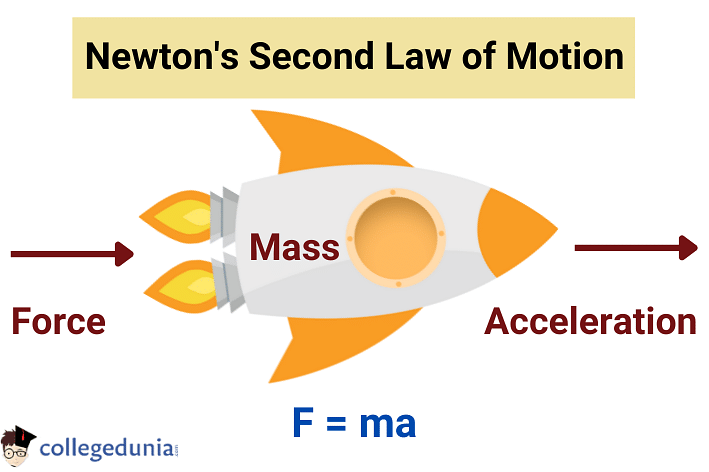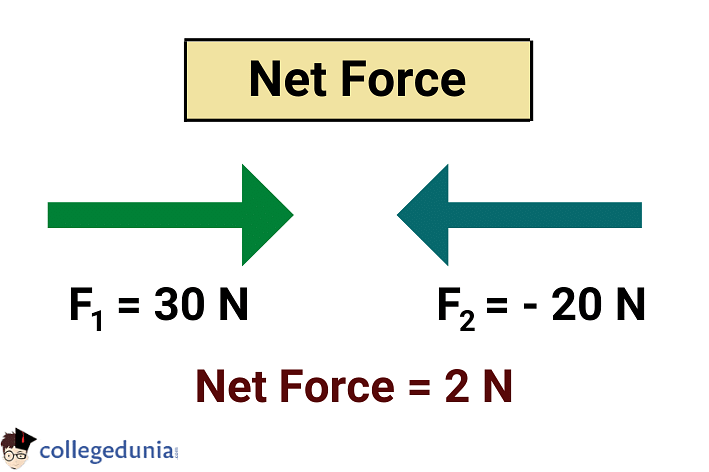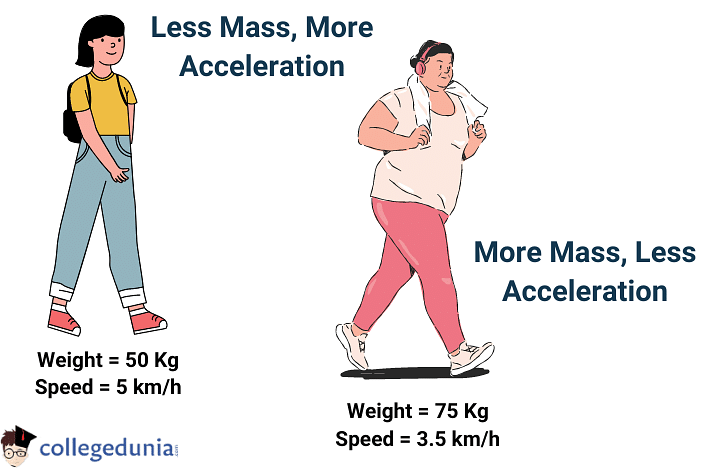Muskan Shafi Education Content Expert
Education Content Expert
Newton’s Second Law of Motion is one of the three fundamental laws of motion proposed by Sir Isaac Newton. Newton’s Second Law of Motion states that the rate of change of momentum of an object is proportional to the applied force.
- Newton’s second law of motion states the relationship between the force and acceleration of an object.
- According to the law, an object will not change its motion unless a force acts on it.
- Newton’s second law of motion quantitatively describes the changes a force produces in the motion of the body.
- The law states that the rate of change of momentum of an object is equal to the applied force in magnitude and direction.
Mathematically, Newton’s Second Law of Motion is expressed as
\(Force ∝ {Change \;in \;Momentum \over Time \;Taken}\)
Read More: NCERT Solutions For Class 11 Physics Laws of Motion
Key Terms: Newton’s Second Law of Motion, Motion, Acceleration, Force, Momentum, Unbalanced Force, Magnitude, Velocity, Mass
Newton’s Second Law of Motion
[Click Here for Sample Questions]
Newton’s Second Law of Motion gives the relationship between the force and acceleration of any object in the universe. The law states that
| “The rate of change of momentum of an object is directly proportional to the applied force.” |
According to the Newton’s Second Law of Motion:
- Force is equal to the rate of change of momentum in an object.
- For a constant mass, force is equal to the product of mass and acceleration.
Laws of Motion Video Lecture
- Acceleration is directly proportional to the unbalanced force and inversely proportional to the mass of the object.
- If the force acting upon an object is increased, the acceleration of the object will also be increased.
- If the mass of an object is increased, the acceleration of the object will be decreased.

Newton’s Second Law of motion is mathematically expressed as
| \(Force ∝ {Change \;in \;Momentum \over Time \;Taken}\) |
Using the appropriate symbols, it can be written as
| \(F ∝ {dP \over dT}\) |
Where
- F is the Force.
- dP is Change in Momentum.
- dT is Change in Time Taken.
Read More:
What is Momentum?
[Click Here for Previous Years' Questions]
Momentum of a body is defined as the product of the mass of the body and its associated velocity.
- Momentum is a vector quantity which means it has both magnitude as well as direction.
- According to the second Law of motion, the time rate of change of momentum is equal to the force acting on the particle.
- Mathematically, Momentum = Mass × Velocity.
- The unit of momentum is kg m/s.
Momentum (p) of an object of mass (m) moving with velocity (v) is given as:
| p = m × v |
Read More: Laws of Motion Class 11 Important Questions
What is Net Force?
[Click Here for Sample Questions]
Net force is the sum of all forces acting on a body or an object.
- Net force is the vector sum of all forces acting on a body.
- It is denoted by the symbol ΣF.
- Net force leads to the acceleration of the mass.
Example: Consider that two forces of the magnitude of 30 N and 20 N are exerted on the right and left of the horse. Assuming the rightward direction as positive, the net force on the horse will be calculated as:
- ΣF = 30 N – 20 N = 10 N
- ΣF = 10 N to the right

Read More: Laws of Motion MCQs
Derivation of Newton’s Second Law of Motion
[Click Here for Previous Years' Questions]
Newton’s second law of motion states that
\(Force ∝ {Change \;in \;Momentum \over Time \;Taken}\)
Now,
- Initial momentum p1 = mu
- Final momentum p2 = mv
Therefore,
Change in Momentum = p2 – p1 = mv – mu = m(v – u)
Substituting the values in the equation, we get
\(F ∝ {m(v-u) \over t}\)
\(F ∝ {ma } \;\;\;[{(v-u) \over t} = a ] \)
\(F = kma\)
Here,
- F is Force.
- m is Mass of the Object.
- u is Initial Velocity.
- v is Final Velocity.
- a is Acceleration
k is the constant of proportionality and is equal to 1 when the values are taken in the SI unit. Hence, Newton’s Second Law of Motion is expressed as
| F = ma |
For Changing Mass
Assume a body to be at an initial point (0) at location L0 and at the time instance t0.
- Let us assume the body has mass m0 and travels with a uniform velocity of v0.
- Force F is applied to the body such that the body moves to point 1, situated at the location L1, and reaches the point at time t1.
- The mass and velocity of the body undergo a transformation as the body travels to v1.

On deriving the values for m1 and v1, we get
\(F = {m_1v_1-m_0v_0 \over t_1-t_0}\)
For Constant Mass
For a constant mass, Newton’s second law can be equated as follows:
\(F = m{v_1-v_0 \over t_1-t_0}\)
Read More: Mass Formula
Solved Examples on Newton’s Second Law of MotionExample 1: What will be the net force required in order to accelerate a 1000 kg car at 4 m/s2? (2 marks) Solution: Given that
Using Newton’s Second Law of Motion, F = m × a 1000 kg × 4 m/s2 = 4000 N Thus, the horizontal net force which is required to accelerate 1000 kg is 4000 N. Example 2: What will be the acceleration if the net force of 12 N is applied to a 1 kg object? Solution: It is given that,
Using Newton’s Second Law of Motion, F = m × a
Thus, the acceleration of the object will be 12 m/s2. |
Applications of Newton’s Second Law of Motion
[Click Here for Sample Questions]
Newton’s second law of motion is used in identifying the amount of force needed to make an object move or to make it stop. Given below are a few examples and phenomena for which the explanation is provided by Newton’s second law of motion.
Pushing a Cart
- Force is directly proportional to the mass of the object.
- Thus, we can see that it is easier to push an empty cart in a supermarket than it is to push a loaded one.
- A heavier mass upon application of the same force will show a smaller acceleration.

Kicking a Ball
- In order to kick a ball, we exert force in a specific direction.
- The stronger the force we put on it, the stronger the ball is kicked, and the further away it will travel.
Two People Walking
- Consider two people walking on a road.
- if one person is heavier than the other, the one weighing heavier will walk slower
- It is because the acceleration of the person weighing a lighter is greater.

Also Check:
Things to Remember
- Newton’s Second Law of Motion states that the rate of change of momentum of an object is proportional to the applied force.
- Acceleration is directly proportional to the unbalanced force and inversely proportional to the mass of the object.
- Newton’s Second Law of Motion is expressed as Force ∝ Change in Momentum / Change in the Time Taken.
- According to the law, F = ma, where m is the mass of the object and a is the acceleration.
- Newton’s second law of motion is applicable when there is an unbalanced force acting on an object.
Previous Years’ Questions
- From the top of a tower, a body A is projected vertically up … [JKCET 2007]
- Assuming earth to be an inertial frame … [JKCET 2009]
- A body sliding on a smooth inclined plane requires … [JIPMER 1999]
- A body of mass 5 kg is suspended by a spring balance on an inclined plane … [BITSAT 2006]
- A body of mass M hits normally a rigid wall with velocity V … [BITSAT 2018]
- A man of weight 80 kg is standing in an elevator … [DUET 2003]
- A light inextensible string that goes over a smooth fixed pulley … [BITSAT 2013]
- A ball is released from the top of a tower … [JKCET 2007]
- There are two identical springs each of spring constant … [UPSEEE 2017]
- A 10gm bullet moving directly upward at 1000 m/s strikes … [UPSEEE 2017]
- A body slides down a frictionless inclined plane starting from rest … [UPSEE]
- A force F = 75N is applied on a block of mass 5kg … [UPSEE 2016]
- A wooden box lying at rest on an inclined surface of a wet wood … [TS EAMCET 2017]
- Two forces P and Q of magnitude 2F and 3F … [JEE Mains 2019]
Sample Questions
Ques. What is Newton’s Second Law of Motion? (3 Marks)
Ans. Newton’s Second Law of Motion is one of the three Laws of Motion given by Isaac Newton. Newton’s Second Law of Motion states that force is equal to the rate of change of momentum. It states that the acceleration of an object is directly proportional to the magnitude of the net force, in the same direction, and inversely proportional to the mass of the object. According to the law, F = ma, where m is the mass of the object and a is the acceleration.
Ques. What will be the net force needed to accelerate a 2500 kg truck at 5.50 m/s2? (3 Marks)
Ans. Given that
Acceleration (a) = 5.50 m/s2
Mass of the Truck (m)= 2500 kg
Using Newton’s Second Law of Motion
Force = mass × acceleration
F = 2500 × 5.5
F = 13750 N
Thus, the net force needed to accelerate a 2500 kg truck at 5.50 m/s2 is 13750 N.
Ques. Calculate the acceleration if a net force of 6 N is applied on 0.5 kg-material. (3 Marks)
Ans. We are given that,
Force (F) = 6 N
Mass (m) = 0.5 kg
Acceleration (a) =?
Using Newton’s Second Law of Motion
Force = mass × acceleration
F = m × a
a = F/m
a = 6/0.5
a = 12 m/s2
Thus, the acceleration of the material is 12 m/s2.
Ques. Give some real-life applications of Newton’s Second Law of Motion. (3 Marks)
Ans. Some of the applications of Newton’s Second Law of Motion in real life are:
- It is easier to push a car in comparison to a truck with the same amount of force as the mass of the car is lesser than the mass of the truck.
- In a golf game, the change in acceleration of the golf ball is directly proportional to the force with which it is being hit by the player through the golf stick.
- Rockets tend to move faster due to the force applied known as thrust and undergo a change in acceleration.
Ques. A net force of 70 N is constantly applied on a 1.4 kg body at rest. Calculate the time taken by the body to attain the velocity of 150 m/s. (3 Marks)
Ans. Given that,
- Force (F) = 70 N
- Mass of Body (m) = 1.4 kg
- Initial velocity = 0 m/s
- Final velocity = 150 m/s
- t = ?
First, we will calculate the acceleration using Newton’s Second Law of Motion,
Force = Mass × Acceleration
F = m × a
- a = F/m
- a = 70/1.4
- a = 50 m/s2
Using the equations of motion, we get
v = u + at
150 = 0 + (50 × t)
150 = 50 × t
t = 150/50 = 3 seconds.
Thus, the time taken to attain the velocity of 150 m/s is 3 seconds.
Ques. What is Motion? (2 Marks)
Ans. Motion is defined as the change in position of a body based on its surroundings in a given time interval. The motion of any object with mass can be measured in distance, displacement, speed and velocity, acceleration, and time.
Ques. How is Newton’s second law applicable to a car crash? (2 Marks)
Ans. Newton’s second law of motion states that force is the product of mass and acceleration. The force in a car crash depends either on the mass or the acceleration of the car. If the acceleration or mass of the car increases, the force with which a car crash takes place will also increase, leading to a greater accident.
Ques. A body of mass 10 kg is moving with a constant velocity of 4 m/s on the frictionless ground. Find the force required to keep the body moving with the same velocity. (3 Marks)
Ans. It is given that
Mass (m) = 10 kg
Acceleration (a) = 0 (As the velocity is the same.)
F =?
Using Newton’s Second Law of Motion,
Force = mass × acceleration
F = 10 × 0
F = 0
Ques. How is Newton’s second law of motion applicable to rockets? (3 Marks)
Ans. According to Newton’s second law of motion, force is a product of mass and acceleration (F = ma). When force is applied to a rocket, it is called thrust. The greater the thrust or force will be, the greater will be the acceleration of the rocket. Acceleration is also dependent on the mass of the rocket’. It means the lighter the rocket, the faster will be the acceleration or vice versa.
Ques. Calculate the net force required to accelerate a 1000 kg car at 8 m/s2. (3 Marks)
Ans. It is given that
Acceleration of Car (a) = 8 m/s2
Mass ofCar (m)= 1000 kg
Using Newton’s Second Law of Motion,
F = m × a
F = 1000 kg × 8 m/s2
F = 8000 N
Check-Out:






Comments